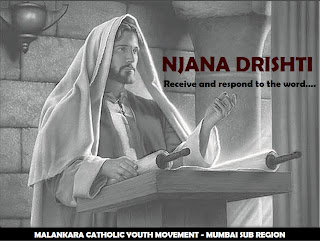ETRI Secretary Jinu Jacob has came to Mumbai for job related issues & he visited the Ulhasnagar unit
YuvaDhwani
|
FOREWORD
The first ever Youth Assembly of the MCYM at the ETRI level was held at Pune in the month of February this year. The Assembly gave out a clarion call to the Malankara Youth in the ETRI to evangelize the whole of India. It suggested Neo Evangelization as a first step towards achieving this glorious mission envisaged by Mar Ivanios, the venerable first Archbishop of the Malankara Catholic Church. The Assembly challenged the youth to bring about a spiritual renewal in their personal lives and to spread the fruits achieved by the same into the Church and the human society at large. This year MCYM Ulhasnagar aspires to respond to this challenge put forth by the Youth Assembly and to take up the evangelizing mission of Christ Jesus in our lives. As Christian youth, we earnestly desire to embark upon a spiritual journey and to serve as willing companions to those who accompany us on this path. “Set your house in order…” (2 Kings 20: 1). Taking the cue from the prophetic saying of Prophet Isaiah to King Hezekiah to set the house of Judah in order, we wish to set our house, MCYM Ulhasnagar in good order as a first step in our evangelizing mission. The blog(name) has been designed as a humble beginning to this daunting endeavour. It is intended to act as a ceaseless reminder to us while engaging in this challenging task. While soliciting your prayers and support, we invite all good souls to join hands with us and get filled with the Word so that together we may bring about the evangelization of our motherland. |
|---|
|
MCYM-ULHASNAGAR
NEWS AND EVENTS MCYM UNIT EXECUTIVE FOR THE YEAR 2013-14
Director: Fr. John Britto OIC *Sportista'13 : 14 November-2013 *Medical Camp : December 2013 *Carol Competition : December-2013 *Y'ZEST-2013 : 26,January-2014 |
|---|
Sunday, 3 November 2013
MSR Agenda Inauguration 15 August 2013
ETRI Secretary Jinu Jacob has came to Mumbai for job related issues & he visited the Ulhasnagar unit
Monday, 22 October 2012
The Rosary...
History of Rosary Beads
Roman Catholic Rosary
Eastern Orthodox Chotki
Buddhist and Hindu Mala
Islamic Subhah
Courtesy : Lifescript.com
Sunday, 14 October 2012
A Life Story of our Pithavu Mar Ivanios
Monday, 1 October 2012
PRAYER WEB
PRAYER WEB
Intentions for September :
- A person who has cancer in her intestine and in last stage please pray for her.
- A sister who has cancer from last ten years and it is detected in the last stage please pray for her.
- Pray for MCYM ulhasnagar.
- A person who has lost his job and suffering from financial and mental crisis.
Intentions for October & November :
- Pray for the
success of Bhopal Convention.
- Pray for MCYM
members who has exams going on this month.
- Pray for Toju achan of etri who is
undergoing serious conditions.
- Pray for MCYM
members who has personal intentions to be
satisfied.
- Pray for a
member who want job.
Intentions for December:
Intentions for December:
- pray for students who having exams in this coming week
- pray for the y'zest event
Sunday, 26 August 2012
Njaana Drishti
On this day it was suggested that the youth should be made avail the translated version of the column. Considering this suggestion, kindly find links to the English translated pdfs from chapters 1-16.
Njaana Drishti 02
Njaana Drishti 03
Njaana Drishti 04
Njaana Drishti 05
Njaana Drishti 06
Njaana Drishti 07
Njaana Drishti 08
Njaana Drishti 09
Njaana Drishti 10
Njaana Drishti 11
Njaana Drishti 12
Njaana Drishti 13
Njaana Drishti 14
Njaana Drishti 15
Njaana Drishti 16
Do enlighten yourself...Happy reading :)
Courtesy: 'Njaana Drishti' by Rev. Fr. Dr. John Berchmans OIC
Visal Malankara Voice
Sunday, 13 May 2012
Blood Donation Camp
Blood Donation Camp
MCYM Ulhasnagar joined hands with ARPAN BLOOD
BANK Kalyan to conduct a blood donation drive on Sunday, 29 April 2012 at
St. Joseph's Bethany Convent School, Ulhasnagar. The blood donation drive was a
grand success with around 52 donors from different parts of Mumbai donating
blood and rendering a great service to human society.
The camp commenced at 10.00 am and was
wound up by 4.00 pm. Members of MCYM Ulhasnagar took a great deal of effort to
plan, organise and conduct the camp with the members of the core group leading
from the front.
MCYM Ulhasnagar wishes to thank every
individual who had been instrumental in making this effort a grand success. We
extend our sincere gratitude to Rev. Fr. Sam Pathackal, the MCYM Director of
Mumbai-Vasai region, who visited the camp and donated blood. We also thank
Rev.Fr. Pius George OIC, MCYM Unit Director for his support and encouragement.
We thank the Bethany
Sisters for providing the school premises for the program. Special thanks are
due to the parishioners of Ulhasnagar unit, Unit MCYM Animators, MCYM Sakinaka
and Vikhroli
A big word of gratitude to ARPAN BLOOD BANK-KALYAN
Photos: Joicy Thankachan
Editor: Renjit Varghese
|
|---|




















